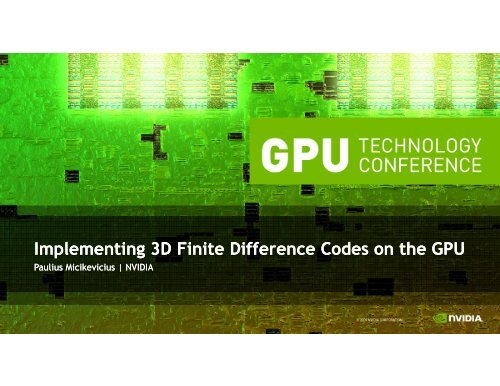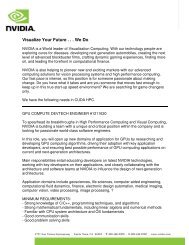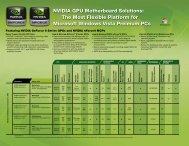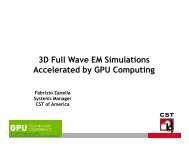Implementing 3D Finite Difference Codes on the GPU
Implementing 3D Finite Difference Codes on the GPU
Implementing 3D Finite Difference Codes on the GPU
You also want an ePaper? Increase the reach of your titles
YUMPU automatically turns print PDFs into web optimized ePapers that Google loves.
<str<strong>on</strong>g>Implementing</str<strong>on</strong>g> <str<strong>on</strong>g>3D</str<strong>on</strong>g> <str<strong>on</strong>g>Finite</str<strong>on</strong>g> <str<strong>on</strong>g>Difference</str<strong>on</strong>g> <str<strong>on</strong>g>Codes</str<strong>on</strong>g> <strong>on</strong> <strong>the</strong> <strong>GPU</strong><br />
Paulius Micikevicius | NVIDIA
Outline<br />
• Single <strong>GPU</strong> Implementati<strong>on</strong><br />
– 2-pass and 1-pass approaches<br />
– Performance evaluati<strong>on</strong><br />
• Multi-<strong>GPU</strong> Implementati<strong>on</strong><br />
– Scalability <strong>on</strong> clusters
<str<strong>on</strong>g>3D</str<strong>on</strong>g> <str<strong>on</strong>g>Finite</str<strong>on</strong>g> <str<strong>on</strong>g>Difference</str<strong>on</strong>g><br />
• 25-point stencil (8 th order in space)<br />
• Isotropic: 5 distinct coefficients<br />
• For each output element we need:<br />
– 29 flops<br />
– 25 input values<br />
• Some applicati<strong>on</strong>s:<br />
– FD of <strong>the</strong> wave equati<strong>on</strong><br />
(oil & gas explorati<strong>on</strong>)
General Approach<br />
• Tile a 2D slice with 2D threadblocks<br />
– Slice is in <strong>the</strong> two fastest dimensi<strong>on</strong>s: x and y<br />
• Each thread iterates al<strong>on</strong>g <strong>the</strong> slowest<br />
dimensi<strong>on</strong> (z)<br />
– Each thread is resp<strong>on</strong>sible for <strong>on</strong>e<br />
element in every slice<br />
– Also helps data reuse
Naive Implementati<strong>on</strong><br />
• One thread per output element<br />
• Fetch all data for every output element<br />
– Redundant: input is read 25 times<br />
– Required bandwidth = 25 reads, 1 write (26x)<br />
• Access Redundancy:<br />
– Metric for evaluating implementati<strong>on</strong>s<br />
– Ratio between <strong>the</strong> elements accessed and <strong>the</strong> elements processed<br />
• Appropriate for user-managed-cache architectures<br />
• Optimizati<strong>on</strong>: share data am<strong>on</strong>g threads<br />
– Use shared memory for data needed by many threads<br />
– Use registers for data not shared am<strong>on</strong>g threads
Using Shared Memory: 2 Passes<br />
• <str<strong>on</strong>g>3D</str<strong>on</strong>g>FD d<strong>on</strong>e with 2 passes:<br />
– 2D-pass (2DFD)<br />
– 1D-pass (1DFD and output of <strong>the</strong> 2D-pass)<br />
• SMEM is sufficient for 2D subdomains<br />
– Square tiles require <strong>the</strong> smallest halos<br />
– Up to 64x64 storage (56x56 subdomain)<br />
• 76.5% of storage is not halo<br />
• Volume accesses:<br />
– Read/write for both passes<br />
– 16x16 subdomain tiles: 6.00 times<br />
– 32x32 subdomain tiles: 5.50 times<br />
– 56x56 subdomain tiles: 5.29 times
Input Reuse within a 2x2 Threadblock<br />
y<br />
z<br />
x<br />
• Store <strong>the</strong> xy-slice in SMEM<br />
• Each thread keeps its 8 z-elements in registers<br />
– 4 “infr<strong>on</strong>t”, 4 “behind”<br />
Used by at least 2 threads<br />
Used <strong>on</strong>ly by thread (0,0)<br />
Used <strong>on</strong>ly by thread (0,1)<br />
Used <strong>on</strong>ly by thread (1,0)<br />
Used <strong>on</strong>ly by thread (1,1)
y<br />
Process at z = k<br />
z<br />
x<br />
Stored in SMEM<br />
Stored in registers<br />
Value we “track”
y<br />
Process at z = k+1<br />
z<br />
x<br />
Stored in SMEM<br />
Stored in registers<br />
Value we “track”<br />
Newly-read value
y<br />
Process at z = k+2<br />
z<br />
x<br />
Stored in SMEM<br />
Stored in registers<br />
Value we “track”<br />
Newly-read value
y<br />
Process at z = k+3<br />
z<br />
x<br />
Stored in SMEM<br />
Stored in registers<br />
Value we “track”<br />
Newly-read value
------- advance <strong>the</strong> slice (move <strong>the</strong> thread-fr<strong>on</strong>t) ------------------behind4<br />
= behind3;<br />
behind3 = behind2;<br />
behind2 = behind1;<br />
behind1 = current;<br />
current = infr<strong>on</strong>t1;<br />
infr<strong>on</strong>t1 = infr<strong>on</strong>t2;<br />
infr<strong>on</strong>t2 = infr<strong>on</strong>t3;<br />
infr<strong>on</strong>t3 = infr<strong>on</strong>t4;<br />
infr<strong>on</strong>t4 = g_input[in_idx];<br />
in_idx += stride;<br />
out_idx += stride;<br />
__syncthreads( );<br />
// ------- update <strong>the</strong> data slice in smem ---------------------------------if(<br />
threadIdx.y
Using Shared Memory: Single Pass<br />
• Combine <strong>the</strong> 2D and 1D passes<br />
– 1D pass needs no SMEM: keep data in registers<br />
• 16x16 2D subdomains<br />
– 16x16 threadblocks<br />
– 24x24 SMEM storage (2.25KB) per threadblock<br />
• 44% of storage is not halo<br />
• Volume is accessed 3 times (2 reads, 1 write)<br />
• 32x32 2D subdomains<br />
– 32x16 threadblocks<br />
– 40x40 SMEM storage (6.25KB) per threadblock<br />
• 64% of storage is not halo<br />
• Volume is accessed 2.5 times (1.5 reads, 1 write)
25-point Stencil Performance<br />
Implementati<strong>on</strong> naïve 2-pass 1-pass 1-pass<br />
Tile dimensi<strong>on</strong>s 16x16 32x32 16x16 32x32<br />
App. Redundancy 26.00 5.50 3.00 2.50<br />
Hw. Redundancy 29.80 5.75 3.50 2.75<br />
Gpoints/s 0.57 3.03 3.73 4.16
Performance for Various Stencil Sizes<br />
order<br />
Gpoints/s<br />
Throughput<br />
instr GB/s, app GB/s, hw<br />
Redundancy<br />
app hw<br />
SM<br />
threads<br />
2 5.09 0.87 45.97 63.81 2.250 3.125 1024<br />
4 4.97 0.82 49.88 64.79 2.500 3.250 768<br />
6 4.03 0.81 44.60 54.67 2.750 3.375 768<br />
8 3.73 0.88 45.08 52.54 3.000 3.500 512<br />
10 3.50 0.79 45.93 51.18 3.250 3.625 512<br />
12 3.22 0.69 45.55 48.77 3.500 3.750 512<br />
16x16 tile, 640x640x400 volume
Multi-<strong>GPU</strong> Implementati<strong>on</strong><br />
• Hardware:<br />
– 2 <strong>GPU</strong>s per cluster node<br />
– Infiniband SDR interc<strong>on</strong>nect<br />
• Approach:<br />
– Partiti<strong>on</strong> <strong>the</strong> volume am<strong>on</strong>g CPU threads<br />
• Each CPU thread drives its own <strong>GPU</strong><br />
• Use standard APIs (MPI/OpenMP) to run multiple CPU threads<br />
– Partiti<strong>on</strong> al<strong>on</strong>g <strong>the</strong> slowest-varying dimensi<strong>on</strong><br />
• Ghost regi<strong>on</strong>s will be c<strong>on</strong>tiguous in memory<br />
• Performance numbers: Gpoints/s for <str<strong>on</strong>g>3D</str<strong>on</strong>g>FD<br />
– Single <strong>GPU</strong>: 3 Gpoints/s (compared to 3.7 Gpoints/s for stencil-<strong>on</strong>ly)<br />
– 2 more reads and 4 more flops per output element, when compared to stencil <strong>on</strong>ly
------- advance <strong>the</strong> slice (move <strong>the</strong> thread-fr<strong>on</strong>t) ------------------behind4<br />
= behind3;<br />
behind3 = behind2;<br />
behind2 = behind1;<br />
behind1 = current;<br />
current = infr<strong>on</strong>t1;<br />
infr<strong>on</strong>t1 = infr<strong>on</strong>t2;<br />
infr<strong>on</strong>t2 = infr<strong>on</strong>t3;<br />
infr<strong>on</strong>t3 = infr<strong>on</strong>t4;<br />
infr<strong>on</strong>t4 = g_input[in_idx];<br />
in_idx += stride;<br />
out_idx += stride;<br />
__syncthreads( );<br />
// ------- update <strong>the</strong> data slice in smem --------------------------------if(<br />
threadIdx.y
Volume Partiti<strong>on</strong>ing for 2 <strong>GPU</strong>s
Processing Phases for 2 <strong>GPU</strong>s<br />
Phase 1<br />
Phase 2<br />
compute<br />
compute<br />
send<br />
compute<br />
send compute
2-<strong>GPU</strong> Performance using MPI<br />
Communicati<strong>on</strong> per node: 4 PCIe memcopies, 1 MPI_Sendrecv
4-<strong>GPU</strong> Performance using MPI<br />
Communicati<strong>on</strong> per node: 8 PCIe memcopies, 2 MPI_Sendrecv
Multi-<strong>GPU</strong> Performance using MPI<br />
Communicati<strong>on</strong> per node: 8 PCIe memcopies, 3 MPI_Sendrecv
Multi-<strong>GPU</strong> Performance Using MPI+OpenMP
Comparing MPI and MPI+OMP performance
Comparing MPI and MPI+OMP performance<br />
Perf difference due to MPI_Sendrecv within a node
Communicati<strong>on</strong> and Computati<strong>on</strong> Overlap<br />
G2C G2C<br />
MPI_Sendrecv<br />
C2G<br />
MPI_Sendrecv<br />
Communicati<strong>on</strong> and computati<strong>on</strong> when using <strong>on</strong>ly MPI<br />
Time<br />
C2G<br />
Ghost node computati<strong>on</strong><br />
Internal node computati<strong>on</strong><br />
PCIe communicati<strong>on</strong> (CPU-<strong>GPU</strong>)<br />
MPI communicati<strong>on</strong> (CPU-CPU)
Communicati<strong>on</strong> and Computati<strong>on</strong> Overlap<br />
G2C G2C<br />
MPI_Sendrecv<br />
C2G<br />
MPI_Sendrecv<br />
Communicati<strong>on</strong> and computati<strong>on</strong> when using <strong>on</strong>ly MPI<br />
G2C G2C<br />
Time<br />
MPI_Sendrecv<br />
C2G<br />
C2G<br />
C2G<br />
Communicati<strong>on</strong> and computati<strong>on</strong> when using MPI and OpenMP<br />
Ghost node computati<strong>on</strong><br />
Internal node computati<strong>on</strong><br />
PCIe communicati<strong>on</strong> (CPU-<strong>GPU</strong>)<br />
MPI communicati<strong>on</strong> (CPU-CPU)
Computati<strong>on</strong> and Communicati<strong>on</strong> Costs per Node<br />
8 PCIe memcopies<br />
2 MPI_Sendrecv
Computati<strong>on</strong> and Communicati<strong>on</strong> Costs per Node<br />
8 PCIe memcopies<br />
2 MPI_Sendrecv<br />
1.6 GB/s<br />
6.2 GB/s
C<strong>on</strong>clusti<strong>on</strong>s<br />
• <strong>GPU</strong> achieves high throughput for <str<strong>on</strong>g>3D</str<strong>on</strong>g>FD over regular grids<br />
– Bandwidth and instructi<strong>on</strong> rate advantage over CPUs<br />
• Multi-<strong>GPU</strong> <str<strong>on</strong>g>3D</str<strong>on</strong>g>FD performance scales linearly<br />
– For large enough problems, communicati<strong>on</strong> is hidden by computati<strong>on</strong><br />
<strong>on</strong> internal data<br />
– “large enough” depends <strong>on</strong> stencil size and cluster c<strong>on</strong>figurati<strong>on</strong><br />
• Number of network and PCIe transfers<br />
• Multi-<strong>GPU</strong> scaling can be reliably modeled<br />
– Using throughput rates for <strong>the</strong> <strong>GPU</strong>, network, and PCIe bus
Questi<strong>on</strong>s?
















